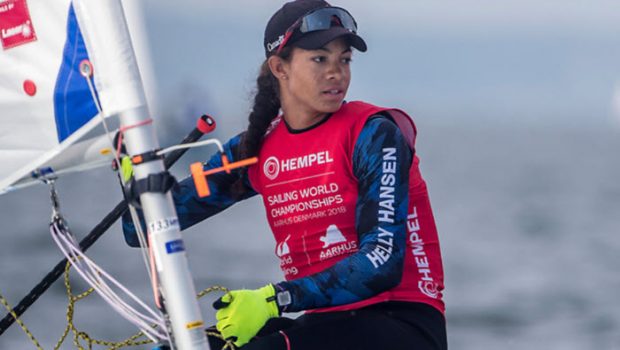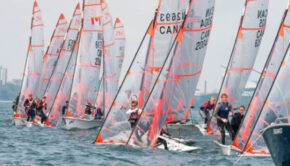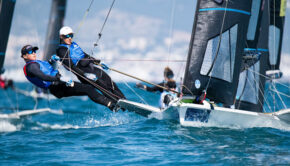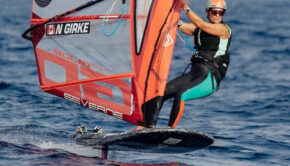Stormy seas clear a sailor’s mind
Published on May 23rd, 2019
Sarah Douglas reflects on experiences that fuel her drive toward representing Canada at the Tokyo 2020 Olympics.
We sail at the sufferance of wind, waves, tides and whatever else the environment throws at us. For all the days of champagne sailing through beautiful venues, there are others that test our ability to endure. In Olympic sailing, I’ve had days when I was surprised to reach land. Days I asked myself, “Why do I do this?”
It was the lead up to the peak event of the summer, the 2017 Laser Radial World Championships in Medemblik, Holland. The Canadian team was in the Netherlands to learn about the venue. It was crucial for us to study the man-made lake we were competing on and to get to know the wind patterns.
For ten days in June, I was training with Canadian coach Vaughn Harrison, Brenda Bowskill (Rio 2016 Olympian), Denmark’s Anne-Marie Rindom (Rio 2016 Bronze medallist), and her coach. We set up training drills on the water and took notes on the conditions each day.
We saw an opportunity to sail our Lasers across the shallow, windswept Ijsselmeer. The forecast was for stronger winds from the south west, which would allow us to sail downwind across the lake from Medemblik to the harbour at Stavoren. Our target marina was approximately 20 kilometres away. We could not see it from where we stood at the sailing centre.
We headed out on the water at 11 a.m. We started with our usual warm up drills. Doing boat handling in that amount of breeze is a real challenge, even for experienced sailors like myself. To give a sense of conditions, racing is cancelled at winds of 25 knots and we were between 20-25. But today we decided that we could handle the wind and we set sail for the cross-lake voyage.
A disastrous picture
It’s 18° C, the water is brackish-brown, and the short, steep waves are a challenge. We decide to leapfrog down — set a downwind mark in the water, race toward it, and then take a break. After about one hour, the wind starts to pick up and the waves really begin to build.
The shallow waters created steep waves, and as you sit on top of them, about to surf downhill, your only option is to do a sharp, 30-degree turn before you hit the trough. Because of the waves’ steepness and the length of the boats, if we continue straight down, the front of the boat would submerge and we’d capsize.
The further we go into the middle of the lake, the bigger the waves grew, and the windier it got. Gusts are now at 30 knots and the sailing went from exhilarating, to unknown. We aren’t sure if we’re going to make it across.
After two hours of going downwind, it starts to get chaotic. A capsize seems inevitable, but we could see land on the other side now. Gusts edge up to 35-40 knots. Water is lifting off the surface of the lake; one momentary mistake and we would be swimming. Three hours pass, and we finally enter the marina in Stavoren. We de-rig our boats, take our masts down, and prepare them to be towed back. The worst is over, I thought. We made it to the other side.
The plan now was to tie our boats together and tow them home after a long journey. Jackets on, protein shakes in hand, we three Canadians were ready to head back to the sailing centre alongside the Danish team, motoring in the boat next to us.
Things get worse
We exit the marina slowly, line our boats up and get ready to go full speed for home. We are sitting in a row in the coach boat, motorcycle style, when we hit the first wave. The boat goes vertical in the air. My teammate and I fall into the back of the boat and the engine starts churning froth and air.
We need more weight in the bow so I sit at the front. With each wave, the bow goes airborne, hangs, then slams down again. I brace for impact; I try to absorb the landings with my legs, but my back takes the brunt of the impact. It feels as though my vertebrae are being compressed.
After about an hour, we hadn’t made much progress. The boat just can’t travel through the waves. We decide to transfer me into the Danish coach boat, which is more powerful. I wave goodbye to my coach and teammate as we race home, hopefully before running out of gas. We zoomed ahead. As we near the sailing centre, I can barely see the Canadian boat on the horizon behind us.
The Olympic dream
During the tow home, I thought about the choices I had made that brought me to one of the scariest sailing days of my life. Time had flown by, but seven years earlier I had retired from competition as a successful youth sailor. I placed second at the 2010 Youth Nationals, the same year I decided that I no longer enjoyed sailing.
In the summers that followed, I coached youth athletes and went to volleyball camp. It wasn’t until 2013, when I was an alternate for the Canada Summer Games, that my Olympic dream was sparked. I was at a Team Ontario camp in Toronto, listening to Olympians, Para-Olympians and Pan Am Athletes talking about their Olympic journey.
One of those athletes was Canadian trampoline gymnast Rosie MacLennan, who described her 2012 London gold medal and what it meant to her. Rosie’s talk re-lit the fire in me. I was inspired again to pursue a medal in sailing. I committed myself fully to training, and to all the choices that go with an Olympic campaign.
Six hours after leaving the dock that morning in 2017, I stepped back onto land with tears in my eyes. It had been such a gruesome day on the water. I thought about how this was part of the journey, that compared to this day, any future sailing would feel easy. Life is about choices and I made mine. I am pursuing my dream and it’s not always going to be smooth sailing.
After that session in Holland, I came back to race at the World Championships and cut my distance from the podium in half from the previous year by finishing 12th overall. I am ranked top 10 in the world now. I often reminisce about that day. It reminds me that I can handle anything on this journey to the 2020 Olympic Games.
Source: CBC Sports









 We’ll keep your information safe.
We’ll keep your information safe.